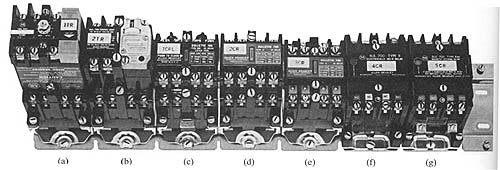AMAZON multi-meters discounts AMAZON oscilloscope discounts
A large variety of relays is available for different applications. Ill. 1 shows seven different types of industrial relays mounted on a rail. In most installations, the rail is mounted in an electrical panel, and each relay is mounted to the rail. The rail makes it easy to remove and replace the relay when it's faulty. In some cases the basic relay is the same, and a different add-on module is mounted to it. Ill. 1a shows a basic relay with an add-on solid-state timer module mounted on it. The add-on timer module allows the timer to convert a basic relay into a time-delay relay. The add-on timer module has one set of NO and one set of NC contacts that are controlled by the delay action.

Above: Ill. 1: Various types of relays available for industrial applications.
(a) Add-on solid-state time-delay relay. (b) Add-on pneumatic time-delay
relay. (c) AC latching relay. (d) AC standard relay. (e) AC standard
relay. (f) Electrically held relay. (g) Magnetic latching relay with
sealed contacts.
Ill. 1b shows a similar relay with a pneumatic add-on timer. The main difference between the solid-state and pneumatic timer is the method that's used to create the time delay. Both relays have an adjustment for setting the amount of time delay.
Ill. 1c shows a latching relay, which is a special type of relay that has a latch coil and an unlatch coil. This type of relay has a mechanism that will cause the contacts to remain in the energized state even after the latch coil is de-energized. The unlatch coil must be energized to return the relay contacts to their de-energized state. That is, this type of relay can be operated with a pulse of AC voltage instead of continuous voltage.
Ill. 1d and Ill. 1e show two types of standard relays. These relays are available with four sets of contacts that are convertible so they can be any arrangement of NO and NC contacts.
Ill. 1f and Ill. 1g show two types of seal-in relays. The contacts in these relays are held in the energized condition like the latch relay. A second coil is required to return the contacts to their normal de-energized condition. Each of the seven sets of contacts can have its coil powered by a variety of AC and DC voltages. The coil can be easily changed to accommodate a different supply voltage, or if the coil is bad.

